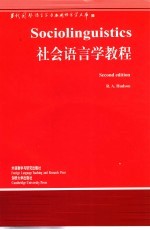图书介绍
社会语言学教程PDF|Epub|txt|kindle电子书版本网盘下载

- R.A.Hudson著;杜学增导读 著
- 出版社: 北京:外语教学与研究出版社
- ISBN:7560020070
- 出版时间:2000
- 标注页数:284页
- 文件大小:13MB
- 文件页数:307页
- 主题词:社会语言学-教材-英文
PDF下载
下载说明
社会语言学教程PDF格式电子书版下载
下载的文件为RAR压缩包。需要使用解压软件进行解压得到PDF格式图书。建议使用BT下载工具Free Download Manager进行下载,简称FDM(免费,没有广告,支持多平台)。本站资源全部打包为BT种子。所以需要使用专业的BT下载软件进行下载。如BitComet qBittorrent uTorrent等BT下载工具。迅雷目前由于本站不是热门资源。不推荐使用!后期资源热门了。安装了迅雷也可以迅雷进行下载!
(文件页数 要大于 标注页数,上中下等多册电子书除外)
注意:本站所有压缩包均有解压码: 点击下载压缩包解压工具
图书目录
1 Introduction1
1.1 Sociolinguistics1
1.1.1 A description1
1.1.2 Sociolinguistics and linguistics2
1.1.3 Sociolinguistics and the sociology of language4
1.2.1 An imaginary world5
1.2 Sociolinguistic phenomena5
1.2.2 A real but exotic world6
Preface by Halliday9
1.2.3 A real and familiar world9
1.3 Speakers and communities10
1.3.1 Conformity and individualism10
王宗炎序10
导读13
1.3.2 The sociolinguistic development of the child14
1.4 Summary and conclusions17
2 Varieties of language20
2.1 Introduction20
2.1.1 Global and specific statements20
2.1.2 Linguistic items21
Preface to the second edition22
2.1.3 Varieties of language22
2.1.4 ‘Speech communities’24
Preface to the first edition24
2.2 Languages30
2.2.1 ‘Language’and ‘dialect’30
2.2.2 Standard languages32
2.2.3 The delimitation of languages34
2.2.4 The family tree model37
2.3 Dialects38
2.3.1 Regional dialects and isoglosses38
2.3.2 Diffusion and the wave theory39
2.3.3 Social dialects41
2.3.4 Types of linguistic item43
2.4 Registers45
2.4.1 Registers and dialects45
2.4.2 Diglossia49
2.5 Mixture of varieties51
2.5.1 Code-switching51
2.5.2 Code-mixing53
2.5.3 Borrowing55
2.5.4 Pidgins59
2.5.5 Crevles63
2.6 Conclusions68
3 Language,culture and thought70
3.1 Introduction70
3.1.1 Culture71
3.1.2 Thought72
3.1.3 Language,culture and thought78
3.2 Linguistic and cultural relativity81
3.2.1 Semantic relativity81
3.2.2 Prototypes85
3.2.3 Basic-level concepts88
3.2.4 Conclusions90
3.3 Language and thought91
3.3.1 Language and socialisation91
3.3.2 The Sapir-Whorfhypothesis95
3.3.3 Sexism in the language system102
3.4 General conclusions104
4 Speech as social interaction106
4.1 The social nature of speech106
4.1.1 Introduction106
4.1.2 The classification of speech109
4.1.3 Speech as skilled work112
4.1.4 The norms governing speech116
4.1.5 Conclusion119
4.2 Speech as a signal of social identity120
4.2.1 Non-relational social categories120
4.2.2 Power and solidarity122
4.2.3 Linguistic signals of power and solidarity127
4.3 The structure of speech132
4.3.1 Entries and exits132
4.3.2 Other kinds of structure in speech134
4.4 Verbal and non-verbal behaviour136
4.4.1 Relation-markers136
4.4.2 Structure-markers138
4.4.3 Content-markers139
4.5 Male/female differences in speech140
5.1 Introduction144
5.1.1 The scope of quantitative studies of speech144
5 The quantitative study of speech144
5.1.2 Why study speech quantitatively?148
5.2 Methodology150
5.2.1 Problems of methodology150
5.2.2 An example:New York155
5.2.3 An example:Novwich159
5.2.4 An example:Belfast163
5.2.5 An example:Cardiff164
5.2.6 An example:Detroit166
5.3 Linguistic variables169
5.3.1 Types of variable169
5.3.2 Calculating scores for texts175
5.3.3 Calculating scores for individuals and groups177
5.4 Influences on linguistic variables181
5.4.1 Linguistic context181
5.4.2 The speaker s group membership184
5.4.3 The speaker s degree of group membership190
5.4.4 The speaker s sex193
5.4.5 The situation and style199
5.5 Summary201
6 Linguistic and social inequality203
6.1 Linguistic inequality203
6.1.1 Introduction203
6.1.2 Three types of linguistic inequality205
6.2 Subjective inequality206
6.2.1 Language-based prejudice206
6.2.2 Evaluation of language209
6.2.3 Stereotypes and how to study them211
6.2.4 Prejudice of teachers216
6.2.5 Prejudice of pupils217
6.3 Linguistic incompetence:strictly linguistic inequality220
6.4 Communicative incompetence:inequality in communication224
7.1 Introduction228
7 Theoretical summary228
7.2 The social functions of language230
7.2.1 Face230
7.2.2 Solidarity and accommodation232
7.2.3 Networks and multiple models234
7.2.4 Social types and acts of identity237
7.2.5 Power240
7.2.6 Analogue relationships and variability241
7.3.1 Background243
7.3 The structure of language243
7.3.2 The history of the isolation of language244
7.3.3 Evidence against the isolation of language245
7.3.4 Two further sources of variability248
7.3.5 Implications for theories of language structure252
Bibliography258
Index271
文库索引280